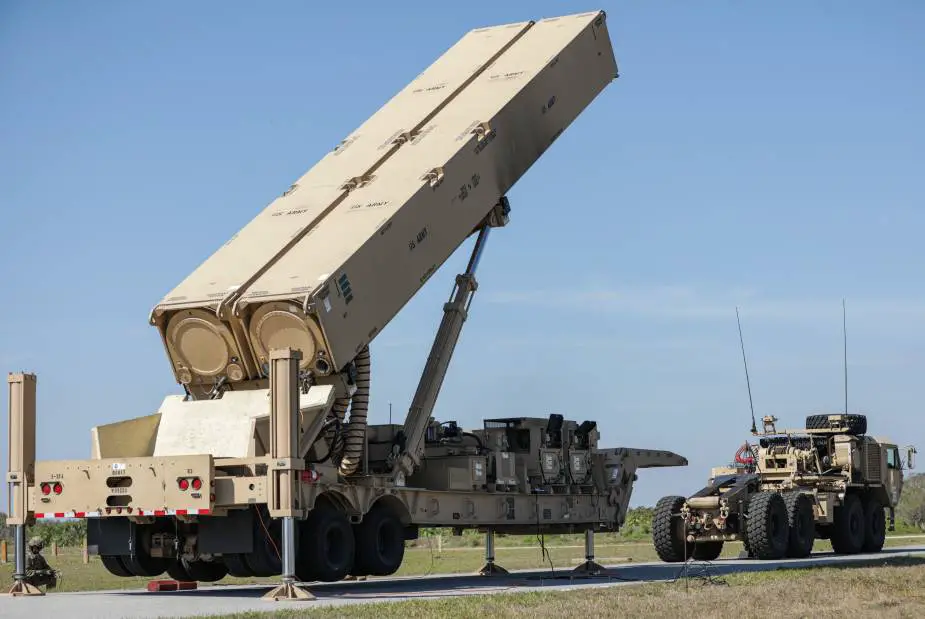Breaking news
1st Multi-Domain Task Force deploys US Army’s first long-range hypersonic missile system.
In February 2023, the 1st Multi-Domain Task Force (1st MDTF) long-range fires battalion, 5th Battalion, 3rd Field Artillery Regiment (5-3 LRFB), deployed the Long-Range Hypersonic Weapon (LRHW) system over 3,100 miles from Joint Base Lewis-McChord, Washington to Cape Canaveral, Florida during Thunderbolt Strike, a full rehearsal of expeditionary hypersonic launch capabilities.
Follow Army Recognition on Google News at this link

A U.S Army soldier lifts the hydraulic launching system on the new Long-Range Hypersonic Weapon (LRHW) during Operation Thunderbolt Strike at Cape Canaveral Space Force Station, Florida, March 3, 2023 (Picture source: U.S. Army/Spc. Chandler Coats)
The LRHW program is a part of the US Department of Defense's efforts to develop and deploy hypersonic capabilities across the armed forces. The LRHW is a ground-launched, long-range missile system that utilizes hypersonic technology to deliver conventional payloads at extremely high speeds over long distances.
Hypersonic weapons travel at speeds of Mach 5 or higher, which is at least five times the speed of sound. These weapons are designed to improve the military's ability to strike time-critical and heavily defended targets quickly while evading enemy defenses. The LRHW's boost-glide technology reduces the missile's heat signature and makes it more difficult to detect and intercept. The LRHW system includes a Transporter Erector Launcher (TEL) vehicle, which transports, erects, and launches the missile. The TEL vehicle allows for the rapid deployment of the LRHW to various locations, enhancing its strategic flexibility.
During Thunderbolt Strike, the deployment of the LRHW system exercised critical command and control linkages between U.S. Indo-Pacific Command, U.S. Strategic Command, U.S. Army Pacific, Army Rapid Capabilities and Critical Technologies Office (RCCTO), and 1st MDTF. Soldiers of the 5-3 LRFB conducted training and practice drills with the LRHW system in Cape Canaveral, processing real missions with real data in real-time to produce real effects to generate readiness. According to Brig. Gen. Bernard Harrington, the 1st MDTF commander, "We’re training the way we will fight, and our Soldiers are ready to deploy and employ this critical capability forward."
Col. Ian Humphrey, RCCTO’s hypersonic weapon integration project manager, noted the 1st MDTF's rapid progress in building the technical and procedural capacity to integrate the LRHW system's capabilities into the Defense Department’s Joint Force. He said, "This unit is fully trained and has proven that they can be deployed away from home station and go right into whatever mission they’re given." Thunderbolt Strike marked a new milestone between the 1st MDTF, RCCTO, industry, and numerous Army partners that generated immediate feedback from stakeholders on the complex system.
As the LRHW program progresses, more specific technical details may become available. However, due to the sensitive nature of the technology and strategic considerations, some information may remain classified. Once operational, the LRHW will provide the US Army with a rapid-strike capability, allowing it to engage targets with unprecedented speed and precision. The system will enhance the US military's strategic and tactical capabilities, particularly in terms of deterrence and rapid response to emerging threats. In an article in Defense Daily, Kathleen Hicks, the US Deputy Defense Secretary, stated that "Our first battery of Long-Range Hypersonic Weapons is training with their ground equipment at JBLM, and by this fall we will have our first battery of Long-Range Hypersonic Weapons, and that element will be part of our 1st Multi-Domain Task Force." She also emphasized the importance of investing in emerging technologies like hypersonic weapons to maintain the US military's technological edge.
Some general characteristics and capabilities of the LRHW can be outlined
Hypersonic speed: The LRHW is designed to travel at hypersonic speeds, which are at least Mach 5 or faster (5 times the speed of sound). This speed allows the missile to cover vast distances quickly and evade enemy defenses more effectively.
Long range: The LRHW is intended for long-range applications, with exact ranges remaining classified. However, long-range hypersonic missiles are typically expected to have a range of over 1,000 miles (1,600 km).
Conventional payloads: The LRHW is designed to carry conventional, non-nuclear warheads, providing the US Army with a rapid-strike capability that minimizes the risk of escalating conflicts.
Boost-glide technology: The LRHW uses boost-glide technology, where the missile is first launched by a rocket booster and then glides toward its target at hypersonic speeds. This approach reduces the missile's heat signature and makes it more difficult to detect and intercept.
Transporter Erector Launcher (TEL) vehicle: The LRHW system includes a TEL vehicle, which transports, erects, and launches the missile. The TEL vehicle allows for the rapid deployment of the LRHW to various locations, enhancing its strategic flexibility.
Precision guidance: The LRHW is expected to have advanced guidance systems that enable it to strike targets with high precision, even at long ranges and hypersonic speeds.
As the LRHW program progresses, more specific technical details may become available. However, due to the sensitive nature of the technology and strategic considerations, some information may remain classified.
Defense News March 2023


























